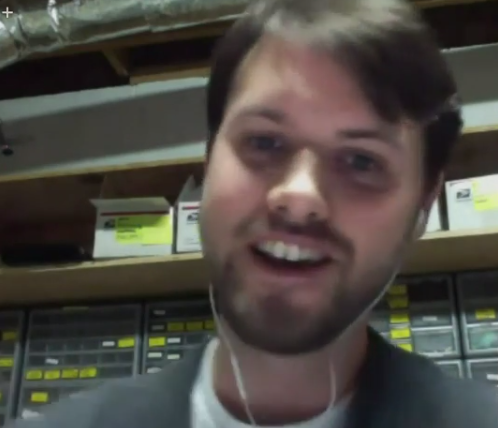Podcast: Play in new window | Download
Subscribe: Apple Podcasts | RSS
Welcome Scott Driscoll, the man behind the Curious Inventor videos on YouTube!

- Scott’s popular soldering videos (which out rank Dave’s) took 100s of hours to learn about (Scott was a novice when he started), make and perfect (Scott continues to be a perfectionist).
[tube]http://www.youtube.com/watch?v=I_NU2ruzyc4[/tube] - He often teaches himself electrical concepts and even went to IPC soldering training. He studied as a mechanical engineer and now works on software.
- The Curious Inventor site also has a wonderful KiCad tutorial (written) that helped Chris back when he was learning.
- Scott used KiCad to design the Vmeter, a capacitive touch device that acts as a MIDI controller.
- The device went through FCC testing, with the help of a friendly FCC engineer. All it took were some strategically placed ferrites.
- This is not uncommon for products to get in trouble; a few years back there was an FCC court case with Behringer, an audio device manufacturer.
- Scott works out of Atlanta and now works full time after deciding not to run the Curious Inventor store/distributorship anymore.
- He now works at Equipcodes, which makes interactive manuals for field training.
- There is an awesome video on the Curious Inventor channel showing an Augmented Reality overlay of a circuit.
[tube]http://www.youtube.com/watch?v=AfVQ4N-u0sk[/tube] - Scott is impressed by 123D Catch and how they can make 3D images from photos.
- Much of the coding they do at work uses a Google apk, which stitches things together using go, python.
- The program used to make the overlay video used the Unity engine which is mostly C# and Javascript
- Back in college as a grad student Scott designed and interacted with a drum robot! Awesome!
- The future of computing will be dependent on MIPS/watt. This could be dependent on battery tech or have alternate on-demand generators.There is a cool triboelectric generator that could do this on your handheld device.
Scott’s personal blog is called Imponderable Things where he discusses any topic that strikes his fancy. Be sure to catch his video explaining Bitcoin! Thanks to Scott for stopping by to tell us about all of his varied projects!

Any links to the curiousity rover’s wire wrapping?
Didn’t see any mention of Ryan O’Hara ‘s engineering notebook at his website (rgb-123.com).. anyone know what the book covers? Project based? FPGAs? Hardware? Hacking?
I think these notebooks are just custom cover lab notebooks, that may cover anything you bother writing into it.
BTW: SLAM (Simultanous Localization and Mapping) names the chicken and egg problem of navigating/creating a model from measurement without a global reference model/position: To get a Scanners position using its measurement a global model (map) is nedded to try to fit it into. To insert new local data into a global model you need its viewpoint (position of the scanner). Usually the solution is iterative and uses in each step the overlap between new data an exiting model.
more about SLAM for interested: it works using photogrammetry
http://en.wikipedia.org/wiki/Photogrammetry
key words VisualSFM, CMVS, Meshlab
http://ccwu.me/vsfm/
http://nghiaho.com/?page_id=253
https://www.youtube.com/watch?v=5QLutxstkw4
tutorial
https://www.youtube.com/watch?v=wBKidr0e-XA&list=PLmtUVJ6R6EoVZGTGq_lPqZvImD1gU8Bfp
implemented on smallish FPGA and integrated into a tiny drone – mapping own position in real time
http://hackaday.com/2014/01/12/autonomous-quadcopter-fits-in-the-palm-of-your-hand/
The best application for AR in electronics would be debugging and troubleshooting. Imagine if you could select a net in the schematic and have the AR system highlight every trace on the board that’s connected to it.
Chris mentioned another podcast, I think it was called innovation ? Does anyone know what the name of it is?